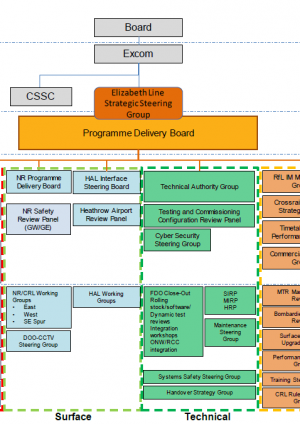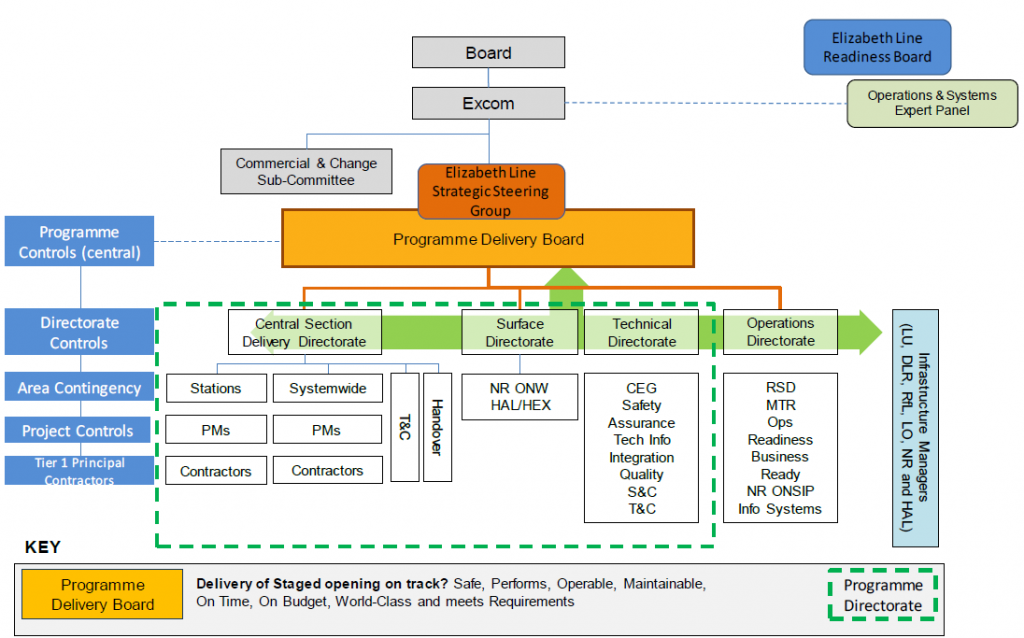
Crossrail Programme Governance
Document
type: Micro-report
Author:
Jonathan Morris MEng
Publication
Date: 02/08/2018
-
Abstract
The Crossrail Project is a very large and complex programme with tight timescales. This document provides an overview of the programme governance framework used at Crossrail to control the leadership, decision-making, reporting and management of the Crossrail Project to achieve its objective to deliver a world-class integrated end-to-end railway, and some of the lessons learned.
-
Read the full document
Introduction
Programme management is the coordinated implementation of a set of related projects and transformation activities in order to achieve an outcome that realises its intended benefits.
During the lifecycle of a programme a series of projects will be initiated, delivered and closed. Programme management complements project management by providing an umbrella under which projects can be coordinated, and their outputs and capability transitioned into operations, whilst maintaining the performance and effectiveness of delivery. It integrates and reconciles multiple interdependencies to manage competing demands by the projects through providing a context and control framework for the overall programme.
Programme governance is about controlling the work: the control framework of individuals, authorities and forums through which a programme can deliver its objectives whilst remaining within corporate visibility and control.
Any programme needs clear and transparent governance if it is to be successful.
Programme Governance Approach
Crossrail is a very large and complex programme that must deliver a safe operable integrated end-to-end railway, on time and on budget, to the requirements set by the Sponsors. CRL (Crossrail Limited) is the nominated undertaker appointed and funded by the Sponsors to manage and implement the Crossrail Project as defined in the Project Development Agreement (PDA) in accordance with an agreed Delivery Strategy. Its governance must be clear where responsibility and accountability rests, and how decisions are made in a controlled way. Crossrail has defined its governance at two levels:
- Corporate Governance – established by the Crossrail Board which sets out delegated authority levels for the Board, its committees and subcommittees as well as the scheme of delegated authorities for the executive directors of CRL.
- Programme governance – which sits beneath this and constitutes all the forums which, in aggregate, control the Crossrail Project in accordance with the Delivery Strategy.
The diagram below illustrates the CRL Programme Management Framework, and the relationship between the CRL Delivery Strategy and its Stage Delivery programme and opening baselines:
Figure 1 – CRL Programme Management Framework
The Programme Director is responsible for both establishing and maintaining programme governance, and ensuring successful delivery of the new capabilities through the projects in accordance with the CRL Delivery Strategy. He is supported in discharging his responsibilities through support offered by both the Programme Controls and Integration teams to assure that:
- Overall integrity and coherence of the programme is maintained
- Strategic drivers are extended into the governance of projects
- Projects are not detached or misaligned from the CRL Delivery Strategy
- Risk profiles and thresholds for both the programme and projects are acceptable
- Decision making on resolving directional issues between interdependent projects is informed by both the latest intelligence, and the CRL Delivery Strategy
- Focus is maintained on the achievement of the ultimate programme mission
Both the Programme Controls and Integration teams provide programme intelligence at the Programme Leadership level, including the highlighting and drawing together of common themes from across the CRL Project, and proactively making suggestions for improvements in the timely direction of the delivery of the new capabilities required, in accordance with the CRL Delivery Strategy. The principal place this is done is the Programme Delivery Board (PDB).
The diagram below illustrates Crossrail’s Programme Governance Map, showing relationships between its key directorates, programme controls team, executive directors and the Infrastructure Managers.
Figure 2 – Crossrail Governance Map
Programme governance is discharged through forums comprised of the individuals who have the expertise and delegated authority to facilitate the delivery of CRL’s obligations. Ultimately delivery is by CRL’s Industry Partners, and its supply chain, so effective governance must extend to management of those in a manner, and to an extent, appropriate to each relationship. This is consistent with the needs of a programme of the scale and complexity of Crossrail. The diagram below illustrates the key forums that are delivered by each directorate across Crossrail:

Figure 3 – Crossrail Programme – Meetings Map
Lessons Learned
Crossrail has always had comprehensive programme governance in place since CRL was set-up. The principal lesson that has been learned is the benefit of maintaining a clear overarching programme governance structure, articulated in a single document that is regularly reviewed by the programme leadership team. Further:
- Decisions must be informed by the right breadth of scope at the right subsidiary level
- Decisions can only be made by individuals with the appropriate delegated authority
- Forums must form a clear and simple hierarchy:
- Each must have a clear purpose and objectives
- Membership will be established against these – it should be clear to all why they are there
- Escalations of issues for decisions, where necessary, must be through a clearly defined route
- Gaps or overlaps of scope must be avoided
- Business must be structured, efficient, recordable and traceable
- Reporting must be simple, accurate and timely (even with complex inputs from many sources)
- Terms of reference must be clear, concise, transparent, in a standard Crossrail format, and widely accessible, as well as approved by the more senior forum
Any changes to the programme governance structure, including the establishment or disbanding of forums, must be notified to the Programme Director, and the whole governance structure should be reviewed for efficiency and fitness-for-purpose whenever there is an impending step-change in the programme lifecycle, or otherwise at a minimum of every 6 months.
Recommendations for Future Projects
CRL would recommend that future major projects:
- Produce and maintain an overarching programme governance framework throughout the lifecycle of the programme
- Standardise and formalise governance in a single document
- Ensure consistency of Terms of References in a standard format for all meetings and forums throughout the organisation, and maintain all of these in a central repository
- Ensure that the principal Programme Delivery Board (PDB) is focussed on reviewing progress towards achieving a successful transition of the programme into operations (in CRL’s case, staged opening) and not just reviewing the delivery progress of the whole portfolio of projects
- Review the whole governance structure for efficiency and fitness-for-purpose whenever there is an impending step-change in the programme lifecycle, or otherwise at a minimum of every 6 months
- Ensure Technical Authority is coordinated across all works, including railway systems, rolling stock and depots, in a single forum that assures the integration against the programme requirements.
- Regularly assure all of the most complex interfaces at a programme level, using a risk based approach, and reviews its Delivery Strategy annually
- Take a “Programme Intelligence” view to programme governance and assurance – this consists both of delivery intelligence (provided by the PMO on cost/risk/schedule) and technical intelligence (collective performance of the railway in assuring that all functional and physical interfaces are on course to perform as the Requirements) at opening.
- Remember that programme management is most effective when issues are debated freely and risks evaluated openly.
-
Document Links
-
Authors
Jonathan Morris MEng - Crossrail Ltd
Jonathan Morris is the Programme Integration Manager at Crossrail. He is responsible for ensuring the integration of the end-to-end railway operates within a clear programme governance structure, and assuring that critical integration issues that support testing and commissioning and handover are identified and resolved in a consistent strategy across the Crossrail organisation. Jonathan started his career in project management in airports and subsequently moved into programme advisory. He now specialises in programme governance, strategic planning, and performance management on major complex programmes where he brings over 13 years experience to bear. He has been with Crossrail since February 2014.




